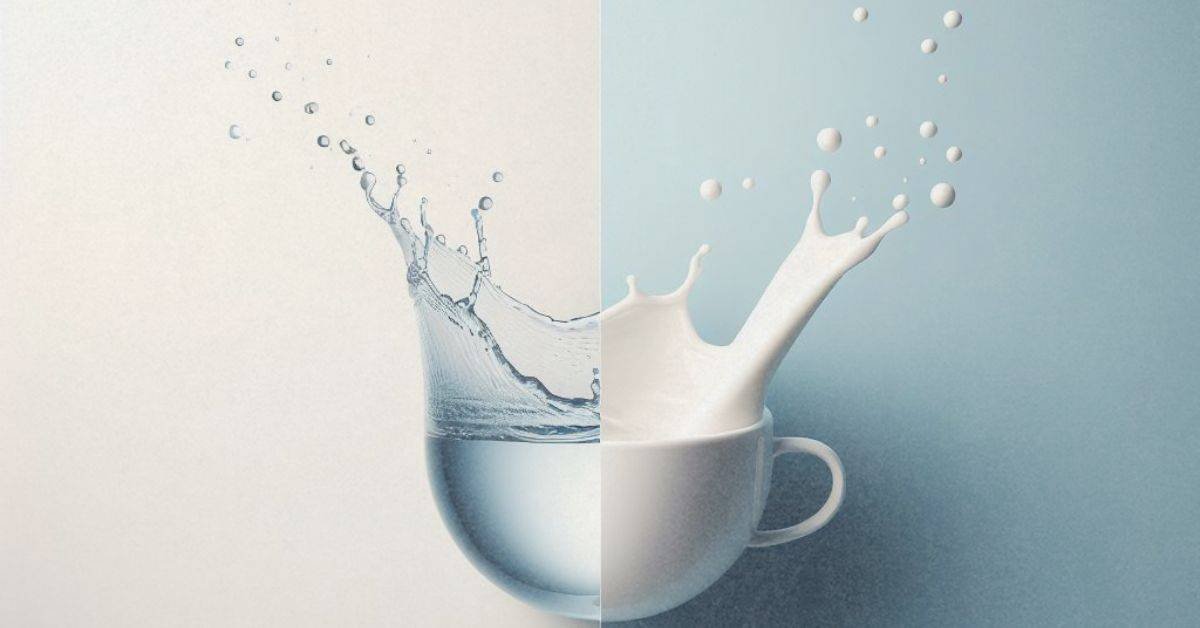
Table of Contents
Your choice of water or milk for protein shakes depends on your taste preference or objectives. Where you are after increasing your protein intake or gaining weight while enjoying a creamier and tastier drink, milk will serve your purpose but if you are after weight loss you may settle for water.
Choices and preferences may differ considerably among individuals. Someone may want to enjoy a creamier drink without gaining weight in which case the type of milk you add to your shake becomes important.
In previous articles, we discussed whether protein powder can cause constipation, how much protein you need by age, what happens if you take too much protein, and egg protein allergy.
In this article, we’ll delve into what makes milk or water a better choice for you based on your needs and also explore two great options for preparing your protein shakes with milk.
Are protein shakes better with milk or water?
None is better than the other on a general note but based on individual preferences and aims for taking them, protein shakes made with milk or water can be better than the other. A glass of milk adds up to 8g of protein to your shake which increases the digestion time.
Below is a table that compares protein shakes with milk or water thereby highlighting instances where each can be considered better than the other.
| Protein shake with dairy Milk | Protein shake with Water |
|---|---|
| Adds more calories. | Adds no calories. |
| Tastes richer and creamier. | Does not. |
| Slower digestion. | Quicker digestion. |
| Higher protein content. | Lower protein content. |
| Better for muscle building. | Not as effective as a milk protein shake for muscle gain due to its lower protein content. |
| Helps with weight gain resulting from extra calories from the milk. | Preferable for weight loss. |
| Not as accessible as water. | Easily accessible |
| Has a thicker texture | Has a lighter texture |
| Suitable for bedtime shakes due to the presence of micellar casein and extra nutrients that combine to reduce digestion and absorption rates. | Not as suitable because of faster digestion and absorption. |
| It does not mix as fast as water and therefore takes more time to prepare. | Less preparation time. |
| The slower digestion and absorption time makes it less suitable for post-workout shakes. | Better for a post-workout shake for faster provision of amino acids for quicker workout recovery. |
| Not for people with milk intolerance. | Suitable for people with milk intolerance. |
If weight gain is part of your reason for taking protein shakes, coconut milk will help you gain extra pounds than cow or almond milk as I’ll highlight later in this article.
Protein shakes with milk or water for weight loss.
A key principle of weight loss is a calorie deficit. While in a deficit your body uses up stored fat for energy which enables the gradual reduction of total fat mass. The loss of fat mass improves your body composition. Though milk provides an additional 8g of protein when used in the preparation of a protein shake, a standard 350 ml of milk needed for the shake adds over 160 calories to your drink.
Water, on the other hand, adds no extra calories to your protein shake. It has zero calories. This is what gives it an advantage over milk where your purpose is to lose weight.
It does not mean you can’t lose weight by using milk in your shakes. You only need to work harder to ensure your daily calorie demand is more than your net calorie intake which enables weight loss over time. In other words, using dairy milk in your shakes demands you increase your level of activity or workout if weight loss is your goal.
Almond milk protein shake.

Almond milk is a calcium-rich, plant-based drink and offers you the option of enjoying a thick, rich, creamy, and tasty protein shake without raising the concerns inherent in the use of dairy milk such as lactose intolerance, saturated fatty acids, it also doesn’t add as many calories to your shake like dairy milk.
Research1 has proven it to be a great alternative to cow/dairy milk without the side effects of lactose intolerance or allergens plus a better nutritional profile than milk from dairy sources.
However, the calories contained in an almond milk protein shake can be significantly increased in a recipe that includes fruits and any other ingredient with significant carbohydrate content.
You can follow this step to make your almond milk protein shake with 250 or 350ml glass of milk:
- Pour some of the milk into a shaker,
- Stir the milk to make a vortex,
- Add a scoop of any protein powder of your choice,
- Stir the mixture to ensure an even mix,
- Pour the remaining milk into the mixture while stirring the whole time,
- Cover the shaker and shake the mixture for several seconds and your almond milk protein shake is ready for consumption.
However, if you wish to add other ingredients like fruits of your choice and nuts to your protein shake you’ll need a blender. In this case, you don’t need to manually stir the mixture during preparation.
Simply add your almond milk and protein powder into a blender, then add your desired fruit, nuts, sweetener, spices, or any other ingredients you like. Cover the lid and blend for a fine, smooth mixture which is your almond milk protein powder.
Note that, depending on your choice of fruit and other ingredients, the additions may increase the number of calories contained in your protein shake.
Kindly keep in touch by signing up for our newsletter:
Cereal milk protein powder.
A lot of folks take cereal for breakfast. While some may want to increase the protein content of their breakfast, others may find the cereal doesn’t keep them satiated long enough. A cereal milk protein powder for breakfast takes care of both desires.
However, preparing this the wrong way will leave lumps of dry protein powder in your breakfast. Take the following steps to avoid this and ensure you enjoy your meal.
- Pour half a glass of milk into a bowl,
- Add your scoop of desired protein powder while stirring the milk and keep stirring till the powder has completely dissolved,
- You may add your cereal to the mixture or pour the mixture on your cereal contained in another bowl,
- Add the remaining half of your glass of milk to your breakfast and enjoy it.
Your choice of milk for this breakfast can measurably determine how much net calories you get from your cereal milk protein. If you expect to get so active and use up a lot of energy before your next meal you may want to use coconut milk for the preparation.
Where you are trying to restrict calorie intake yet want to enjoy the richness of protein shakes prepared with milk, almond milk should be considered as you will see in the next section.
Coconut milk protein shake.

Like almond milk, coconut milk is one of the best alternatives to dairy milk in the preparation of a delicious and nutritious protein shake. It is rich in vitamins like vitamin C, and nutrients like iron, magnesium, potassium, and dietary fiber.
Coconut milk has proven health benefits2 with antioxidant activity and physicochemical properties according to the Journal of Chemical and Pharmaceutical Research.
Coconut milk protein shakes are easy to prepare following the steps described above for almond milk. It can be so tasty that most people may enjoy it with cereal and protein powder for breakfast, prepared just as described earlier in this article.
However, coconut milk contains a considerable deal of calories so may not serve your weight loss goals. It is a good option if you are looking to gain weight by consuming protein drinks as discussed in another article you may want to read. Below is a comparison of the amount of calories contained in 100g of cow, almond, and coconut milk.
- 100g of cow milk: 42 calories.
- 100g of almond milk: 17 calories.
- 100g of coconut milk: 230 calories.
The use of coconut milk for a protein shake before a workout will give you considerably more energy for your workout and when taken after a workout will enhance post-workout recovery. It does this by providing additional protein for repair and extra energy to replenish the energy you use up during your workout.
I hope this piece satisfactorily answers your questions regarding the choice of water or milk for your protein shake. You may drop any questions you may have in the comment section or contact us directly for more clarification. Meanwhile, see you on the next topic.
References.
- Preeti Kundu, Jyotika Dhankhar, Asha Sharma. (2018). Development of Non-Dairy Milk Alternative Using Soymilk and Almond Milk. Department of Food Science and Technology, Maharishi Dayanand University, Rohtak, Haryana, India, 124001. DOI: https://dx.doi.org/10.12944/CRNFSJ.6.1.23 ↩︎
- Agyemang-Yeboah, F. (2010). Health Benefits of Coconut (Cocos nucifera Linn.) Seeds and Coconut Consumption. Nuts and Seeds in Health and Disease Prevention, 361-367. https://doi.org/10.1016/B978-0-12-375688-6.10043-X ↩︎































































































































































Thank you for sharing with us, I think this website genuinely stands out : D.
Wonderful blog! I found it while searching on Yahoo News. i appreciate it